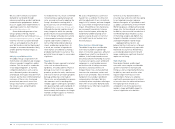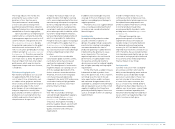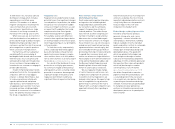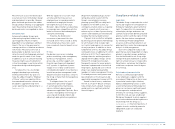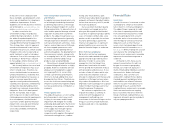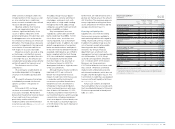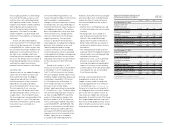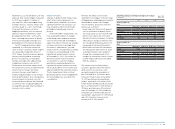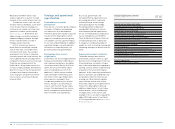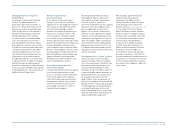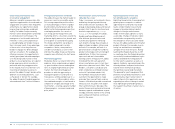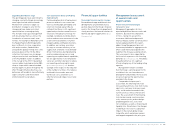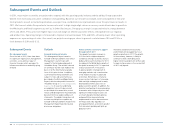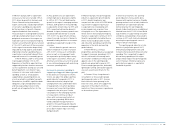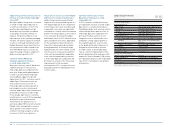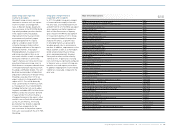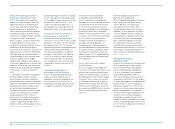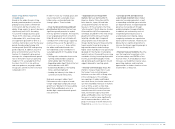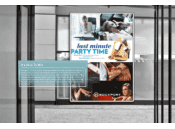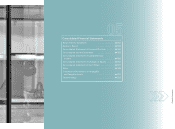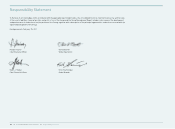Reebok 2010 Annual Report Download - page 176
Download and view the complete annual report
Please find page 176 of the 2010 Reebok annual report below. You can navigate through the pages in the report by either clicking on the pages listed below, or by using the keyword search tool below to find specific information within the annual report.
172 Group Management Report – Financial Review Risk and Opportunity Report
Social media offering new ways
of consumer engagement
Advances in digital communication offer
significant opportunities for our brands to
engage with consumers more frequently
and enhance our opportunity to build
long-lasting relationships and brand
loyalty. The adidas Group constantly
monitors latest developments and trends
in communication technologies. The
emergence of social media and social
networks is one such example which
is already helping our brands increase
their consumer reach. A key advantage
of these tools is that they allow our
brands to engage in a direct dialogue
with our consumers. For example, by
offering consumers the opportunity to
actively participate in brand campaigns
or in the design and creation of new
products, we can generate a far superior
brand experience which resonates in
particular with the young generation.
In this regard, most of our divisions are
investing considerable resources to
present the adidas Group’s brands within
different social media platforms, such
as Facebook or Twitter. For example,
the adidas Originals Facebook page has
attracted more than 7 million followers.
Strong market positions worldwide
The adidas Group is the market leader in
numerous countries around the world.
This strong competitive position offers
us many advantages in terms of global
brand visibility, market power and the
ability to effectively expand our position
in emerging markets. As a result of
our strong partnership portfolio and
marketing efforts, consumers around the
globe are highly aware of our brands and
are receptive to our brand messaging.
This makes demand for our products
more stable compared to smaller
competitors. Hence, many retailers
consider our products as core to their
offering. The adidas Group can therefore
compete more effectively for shelf space.
Multi-brand approach
We believe there is a natural limit to the
audience size a single brand can appeal
to, given the diverse tastes and expecta-
tions of a highly fragmented consumer
market. Our multi-brand approach
provides us with the opportunity to
leverage the power of our brands in a
more precise and meaningful way see
Group Strategy, p. 80. We are able to utilise
the combined strengths of each brand to
compete for a higher percentage of the
total market – covering a greater number
of demographics, consumer needs and
price points.
Personalisation and customisation
replacing mass wear
Today’s consumers are looking for choice
and variety that go beyond choosing
from a wide selection of products. We
engage in developing unique and relevant
products that fit specific functional and
aesthetic requirements see Group
Strategy, p. 80. For example, the adidas,
Reebok and TaylorMade brands all
offer different personalisation and
customisation platforms reflecting
each brand’s strategy. Key concepts at
adidas include mi adidas, miTeam and
miCoach. For example, miCoach is a
personalisation concept that combines
product technologies with an intelligent
web platform. It offers the consumer
a personal and real-time audible
training system. In August 2010, adidas
introduced the miCoach app which
allows smart phone users to turn their
phone into a personal coach. With “Your
Reebok”, consumers can design and
order completely customised footwear
online. At TaylorMade-adidas Golf,
the myTPball online platform offers
customers the opportunity to create
and order their own golf balls, and our
Centers of Excellence provide customised
fitting sessions for golfers with expert
fitters and technicians. We expect the
market for personalised and customised
footwear, apparel and hardware to grow
strongly and evolve further in the coming
years and we will therefore continue to
invest in the space.
Exploiting potential of new and
fast-growing sports categories
Exploiting the potential of emerging, fast-
growing sports categories is another
opportunity for our brands. Our brand
teams conduct market research and
engage in trend marketing to detect
changes in lifestyle and consumer
needs of their target audience as early
as possible. Changes in lifestyle, habits
and attitudes can potentially result in
the emergence of new consumer needs
that are not addressed by current market
product offerings. For example, muscle
toning has evolved into a meaningful
category in less than two years. Having
launched the Reebok EasyTone in 2009
as a walking shoe, the Reebok brand has
successfully introduced additional styles
and has extended the toning platform
to other sports categories as well as to
apparel. Similarly, a growing trend is the
move by athletes and sports enthusiasts
towards more minimalistic products
that promote natural body movement.
The demand for sports equipment that
promotes natural body movement is seen
as potentially a major future trend. In
order to tap into this opportunity, we are
expanding our efforts to bring to market
more lightweight and flexible products
that support the athlete’s natural course
of motion.


